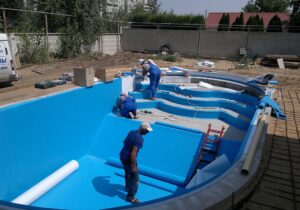Ever thought about how a simple step can be a barrier? For millions of Americans with mobility challenges, a traditional swimming pool can feel more like an obstacle course than an oasis. But what if your backyard pool could be a welcoming space for every single person, regardless of age or physical ability? Creating a truly inclusive swimming experience is not just about meeting regulations; it’s about fostering connection, fun, and well-being for all your loved ones.
By the end of this article, you’ll understand the key principles of accessible pool design. We’ll explore practical, stylish solutions that go beyond the basics, ensuring your pool is a source of joy and relaxation for everyone. From grandchildren with boundless energy to grandparents who move a little slower, a thoughtfully designed pool brings the entire family together.

More Than a Guideline: The Heart of Accessible Pool Design
When we talk about accessible pool design, we’re referring to a set of principles and features that allow safe and easy use by people with disabilities, seniors, and even small children. While The Americans with Disabilities Act (ADA) provides clear guidelines for public pools, these standards offer a fantastic starting point for any residential project. According to the guidelines from the U.S. Access Board, a key requirement for accessibility is having at least one safe means of entry and exit, but a truly universal design often incorporates multiple options.
Think of it this way: an accessible pool doesn’t just tick a box. It enhances the comfort of every user and incorporates essential pool safety features. You’ll find that features designed for accessibility, like wider steps or a gently sloped entry, often become the favorite spot for everyone to relax.
The Entryway: The Most Critical Feature
The most significant aspect of accessible pool design is how people get into the water. Traditional ladders can be difficult for many, but modern solutions blend seamlessly into your pool’s aesthetic while offering superior functionality.
Zero-Depth Entry (Beach Entry)
A zero-depth or “beach” entry is exactly what it sounds like—a portion of the pool with a gentle, continuous slope from the deck into the water, just like a natural shoreline. This is the gold standard for accessibility.
- Who it helps: This design is perfect for wheelchair users, who can roll directly into the water using a submersible wheelchair. It’s also ideal for toddlers, seniors who are unsteady on their feet, and anyone who prefers to wade in gradually.
- Design Tip: A zero-depth entry can be beautifully integrated into a lagoon-style pool, surrounded by natural stone and lush landscaping to create a resort-like feel right in your backyard.
Pool Lifts
A pool lift is a mechanical device, typically battery-powered, that safely transfers a person from the pool deck into the water. Modern lifts are robust, reliable, and can be surprisingly discreet.
- Who it helps: Lifts are essential for individuals who cannot use stairs or a ramp. They provide a secure and dignified way to enter and exit the pool.
- Installation: An ADA-compliant lift must have a minimum weight capacity of 300 pounds and be located where the water depth is no more than 48 inches, allowing a helper to provide assistance from a standing position if needed. At Poseidon’s Custom Pools, we ensure that the installation is not only safe but also positioned for optimal convenience and aesthetic appeal.
Sloped Entries vs. Pool Stairs: A Quick Comparison
While a zero-depth entry is a type of sloped entry, you can also have a more compact ramp. How does this compare to traditional stairs?
| Feature | Sloped Entry (Ramp) | Wide Pool Stairs |
| Accessibility | Excellent for wheelchair users and those with significant mobility issues. | Good for seniors and those with minor mobility challenges. |
| Aesthetics | Can be designed to look natural, like a beach. | Can be a classic, elegant feature with seating areas. |
| Space Required | Requires more space to achieve a gentle, usable slope (max 1:12). | More compact and suitable for smaller pool footprints. |
| Multipurpose Use | Creates a large, shallow area perfect for lounging and for small children to play. | Steps can double as underwater benches for socializing. |
Ultimately, the best choice depends on your specific needs and the overall design of your pool. Many of our clients in Pennsylvania opt for a combination of features, like a main staircase and a strategically placed lift, to accommodate all possibilities.
Beyond the Entry: Essential Features for a Truly Accessible Pool
A great accessible pool design considers the entire experience, from the moment you step onto the deck to the time you get out of the water.
1. Non-Slip Decking: The area around the pool is just as important as the pool itself. Choose a decking material that is non-slip even when wet. Textured concrete, pavers with a high-grip surface, and certain composite materials are excellent choices.
2. Handrails and Grab Bars: Sturdy handrails should be installed on both sides of stairs and sloped entries. Placing additional grab bars at key points inside the pool can provide extra stability for users as they move around.
3. Consistent Depth and Ledges: For users with visual impairments, a pool with a predictable layout is crucial. Consider a consistent depth in certain areas or a clear demarcation for changes in depth. A resting ledge just below the water’s surface along the pool wall provides a welcome spot to take a break.
4. Sensory-Friendly Considerations: Accessibility isn’t just about physical mobility. For individuals with autism or sensory processing disorders, a chaotic pool environment can be overwhelming.
* Calming Water Features: Instead of loud, splashing fountains, opt for calming water features like gentle bubblers or a smooth, cascading waterfall that provides soothing background noise.
* Simple Visuals: Use simple, clean tile lines and avoid overly busy patterns that can be visually jarring.
* Creative Lighting Ideas: Install adjustable LED lighting to change the color and intensity of the pool’s glow. Soft, calming colors like blue and green can create a tranquil atmosphere for an evening swim. Explore these and other creative lighting ideas to set the perfect mood.
Frequently Asked Questions About Accessible Pool Design
- Q: Will an accessible pool look institutional or clinical?
- A: Absolutely not! This is a common misconception. Modern, accessible features can be beautifully integrated into any high-end pool design. A zero-depth entry, for example, is a luxurious feature found in many world-class resorts. At Poseidon’s Custom Pools, we specialize in making functional elements beautiful.
- Q: What is the main difference between a sloped entry and a beach entry?
- A: The terms are often used interchangeably. A “beach entry” typically refers to a wider, more gradual slope that creates a distinct shoreline effect. A “sloped entry” or “ramp” might be a more compact, utilitarian version, but both serve the same primary function of providing wheeled access.
- Q: Is an accessible pool more expensive to build?
- A: Some features, like a pool lift, will add to the initial cost. A zero-depth entry can also be more complex to construct than a standard pool edge. However, it’s helpful to understand the installation costs in full. These features add significant long-term value to your home, making it more marketable and, more importantly, more usable for your family for years to come. Think of it as an investment in a lifetime of shared memories.

Your Pool, Your Sanctuary, for Everyone
Designing a swimming pool is one of the most exciting projects a homeowner can undertake. By prioritizing accessible pool design from the very beginning, you create a space that is truly welcoming for all. It’s a testament to thoughtful hospitality, ensuring that no friend, family member, or guest is ever left sitting on the sidelines. Your backyard oasis can and should be a place of joy, therapy, and connection for people of every ability.
Ready to design a beautiful, custom swimming pool that the whole family can enjoy? Let’s talk about creating a space that is as functional as it is stunning. Share your ideas in the comments below, or contact us today to start planning your perfect, accessible backyard retreat!






